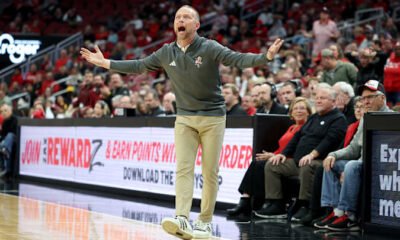Blog
Derrick Henry’s legendary college football story resurfaces, and fans are going crazy about it.
Derrick Henry’s legendary college football story is once again captivating fans—and for good reason. The tale of “King Henry,” from his record-smashing days at the University of Alabama to his meteoric rise as one of the most dominant running backs in football history, has been etched into the annals of college sports. As the buzz of social media and fan discussion continues to reignite around his awe-inspiring collegiate achievements, it’s worth revisiting the journey that made him an overnight sensation and a perennial reference point for greatness.
Early Beginnings: From Yulee to Alabama
Even before stepping onto the gridiron as a collegiate athlete, Henry was destined for greatness. Growing up in Yulee, Florida, he burst onto the high school scene in a way few ever do. At Yulee High School, Henry broke long-standing records—amassing over 12,000 career rushing yards and an astounding number of touchdowns—which not only earned him nationwide recognition but also the early moniker “King Henry.” His blend of imposing size and surprising speed made him a prospect that few could ignore, setting the stage for a path toward the University of Alabama.
Fans still reminisce about the days when local media heralded his almost mythical potential, as he dominated opposing defenses with a combination of raw power and agility. It was this same combination—his ability to pummel through defensive lines while eluding tacklers with balletic speed—that would become the cornerstone of his success at the next level. With offers pouring in from top college programs, Henry’s decision to commit to Alabama signaled that he was ready to step into one of the nation’s most competitive football environments.
The Freshman Year: Laying the Groundwork (2013)
Henry’s arrival at Alabama in 2013 came at a time when the Crimson Tide’s backfield was already loaded with talent. As a true freshman, he played a supportive role alongside stars like T.J. Yeldon and Kenyan Drake. Although his opportunities were limited—he carried the ball only 36 times for 382 yards—his efficiency was eye-popping, averaging an impressive 10.6 yards per carry. These early glimpses hinted at an underlying potential that would soon burst forth when given a larger role on the team. Even in those early days, Henry’s rare combination of size (standing 6‑3 with a robust frame) and uncanny burst of speed set him apart from his peers, planting the seeds of a legacy that would soon defy expectations.
Sophomore Season: Stepping Out of the Shadow (2014)
In his sophomore campaign, Henry began to see more consistent playing time. Splitting the workload with T.J. Yeldon, he started to refine his style and gradually emerge as one of the Crimson Tide’s most reliable weapons on the ground. That season, he amassed 990 rushing yards on 172 carries—averaging 5.8 yards per attempt—and scored 11 touchdowns. His performance in key games, notably in the Sugar Bowl and during the SEC Championship run, showcased his ability to perform under pressure and against top-tier competition.
One of his memorable games during this period came against Florida, where his tenacity and power in breaking tackles helped propel Alabama to a decisive victory. Fans and analysts began to take note of his potential as not merely a backup but as a future star who could lead the entire offense. His performances provided a glimpse into the explosive nature of his running style—a style that combined the bruising power of a downhill runner with an almost elusive quality that even defenders struggled to contain.
The Breakout Junior Campaign: A Season for the Ages (2015)
Henry’s junior season in 2015 represents one of the most legendary individual campaigns in college football history—a season that not only changed the narrative around his career but also redefined what it means to be a dominant running back in the modern era. With T.J. Yeldon now in the NFL, Henry inherited full-time responsibility as the Crimson Tide’s feature back, and he answered with a performance that is still talked about in hushed, reverent tones among fans and analysts alike.
Over the course of 15 games, Henry carried the ball 395 times for an eye-popping 2,219 rushing yards—averaging just 5.6 yards per carry—and scored 28 touchdowns. These numbers were not mere statistics; they were records in the making. Henry broke longstanding benchmarks, including eclipsing Herschel Walker’s single-season SEC rushing record—a record that had stood since 1981. His relentless pursuit of extra yardage and his ability to find the end zone in every game established him as a true workhorse and a record-breaker in every sense of the word.
One of the highlights from that season came during the Iron Bowl against Auburn. In that game, Henry recorded 271 rushing yards on 46 carries—a monumental performance that not only broke school records but also sent shockwaves through the college football world. In the SEC Championship, against a formidable Florida squad, he totaled 189 yards and a touchdown, further cementing his role as the backbone of Alabama’s offensive juggernaut. And then, in the College Football Playoff National Championship against Clemson, Henry’s 158 rushing yards and three touchdowns on 36 carries provided a defining moment in a game that exemplified his impact in high-stakes situations.
A Combination of Physicality and Elusiveness
What makes Henry’s story so compelling is not just the numbers—but the manner in which he achieved them. Standing tall and built like a brick wall yet possessing speed that often left defenders grasping at air, Henry embodied a rare blend of power and grace. Observers noted that “built like a truck, runs like a deer” became a fitting description of his style. His long strides, coupled with his ability to absorb hits and then explode through gaps in the defense, allowed him to accumulate yardage with a consistency that was nearly unmatched.
Research from Pro Football Focus even highlighted his “elusive rating” during his college career—an advanced metric that quantified his ability to force missed tackles and pick up yards after contact. Despite his size, Henry often surprised critics by evading would-be tacklers, a quality that belied his physical frame and contributed significantly to his overall dominance on the field.
Impact on College Football and Alabama’s Legacy
Henry’s 2015 season arrived at a crucial juncture in the evolution of college football. At a time when many programs were shifting their focus to a more pass-oriented attack, Henry’s back-to-basics approach—relying on brute force, endurance, and an ever-present determination to keep churning out yards—served as a reminder of the timeless value of a powerful running game. His performances under the tutelage of legendary coach Nick Saban not only propelled Alabama to a national championship but also revitalized interest in the art of the power run.
By leading the nation in rushing attempts, yards, and touchdowns, Henry’s campaign provided a compelling case for why a dominant running back is still a cornerstone of any championship-caliber team. His ability to wear down defenses over the course of a game and create mismatches in key moments transformed how fans and future teams evaluated the running back position. For many, his college career became a benchmark—an exemplar of what can be achieved with a potent mix of talent and relentless work ethic.
Alabama’s offensive machine, powered by Henry’s record-setting runs, led to widespread national accolades. The season culminated in multiple awards: Henry won the Heisman Trophy, becoming the first Alabama running back to win the prestigious award since Mark Ingram, along with the Doak Walker Award, Maxwell Award, and Walter Camp Award. Each of these honors underscored his status as not just a great college player, but as one of the best to ever play the game at that level.
Fan Reaction and the Resurgence of a Legend
Years after that historic 2015 season, social media and sports forums continue to buzz with reminiscences of Henry’s college exploits. Fans post highlight reels of his explosive runs, comparing his legacy to that of greats like Herschel Walker and Bo Jackson. The story of Henry’s meteoric rise—from a promising high school phenom to a record-breaking force in college football—serves as an enduring source of inspiration and debate among enthusiasts.
For many, it is the sheer improbability of such sustained excellence that elevates Henry’s story to legendary status. Every run, every touchdown, and every moment when he defied the very laws of gravity on the field brings back memories of a season when the impossible seemed not only possible but inevitable. His performance in crucial games helped cement Alabama’s dynasty, contributing directly to the school’s legacy as one of the greatest football programs in history.
Social media platforms are awash with comparisons: fans recall how Henry would dominate defenders, how his powerful strides broke through even the toughest defensive lines, and how his ability to score in nearly every game set him apart from his contemporaries. Memes, video compilations, and heated debates all serve as testament to the lasting impact of his college career. The tale of Henry’s 2015 season is more than just a nostalgic trip—it’s a reminder of a time when the raw power of a running back could carry a team to national glory.
Beyond the Numbers: The Intangible Legacy
While the statistics are staggering—2,219 rushing yards, 28 touchdowns, and countless record-breaking moments—the real magic of Henry’s college journey lies in the intangibles. His work ethic, resilience, and the way he embraced the “grind” every single game were qualities that resonated with fans of all ages. In an era increasingly dominated by spread offenses and pass-heavy strategies, Henry’s bruising, downhill style served as an antidote, reminding the football world of the enduring value of a classic power run.
Henry’s story is also one of overcoming doubt and adversity. Coming into a program as competitive as Alabama, he had to fight for every inch on the field. His early years were spent in the shadow of other talented backs, but his hunger and determination eventually forced his way into the spotlight. Every carry in 2015 felt like a statement—a declaration that he was not just another back, but a once-in-a-lifetime talent.
This narrative of defiance against expectations and the continuous pursuit of excellence has become an archetype in college sports. Coaches, players, and analysts often cite Henry’s season as a prime example of how perseverance and talent, when combined with the right system, can lead to extraordinary success. It’s a story that inspires future athletes to dream big, work relentlessly, and believe that sometimes the impossible is just a few carries away.
The Ripple Effect: Inspiring Future Generations
Derrick Henry’s college legacy does not exist in isolation. His remarkable achievements have influenced recruiting, training, and even game-planning at programs across the nation. Coaches now look for a blend of size and speed in running backs, emulating Henry’s model of a “power back” who can both physically dominate opponents and still have the elusiveness to break free when the defense slips.
Moreover, the buzz around his career has spurred extensive analysis and discussion among sports commentators and fans alike. Advanced metrics—such as his “elusive rating” which measured missed tackles and yards after contact—are frequently invoked to illustrate just how remarkable his performances were. These numbers, while part of the modern analytical landscape, only scratch the surface of what Henry achieved in that unforgettable season.
The lesson for upcoming generations is clear: talent, when honed through hard work and resilience, can defy conventional wisdom. Henry’s ability to overcome the limitations of a crowded backfield and emerge as the star of one of the most storied programs in college football serves as a beacon for aspiring athletes everywhere.
A Lasting Legacy That Transcends Eras
Even now, as Henry continues his illustrious NFL career—first with the Tennessee Titans and now with the Baltimore Ravens—the memory of his college days remains a touchstone for fans and sports historians. That 2015 season is often referenced in debates about the greatest individual seasons in college football history. It is a season defined not only by record-breaking numbers but also by the palpable passion that Henry brought to every game, a passion that endures in every touchdown run he makes on the professional stage.
The reverence for his college career is evident in how frequently his highlights are shared on social media, how his name is invoked in discussions about legacy and greatness, and how former teammates and coaches speak of him with admiration and awe. His college journey is not merely a chapter in his career; it is a foundational myth—a source of inspiration for any player who dares to dream big.
Conclusion: The Enduring Mythos of King Henry
The resurgence of Derrick Henry’s legendary college football story is a testament to the power of greatness on the field. From his record-setting days at Yulee High School to his awe-inspiring performances for the Crimson Tide, Henry has built a narrative that resonates deeply with fans and players alike. His 2015 season remains a high-water mark in college football—a period when every carry, every touchdown, and every explosive run underscored a singular truth: that greatness is forged through resilience, hard work, and an unyielding will to win.
Now, as fans marvel at his continued success in the NFL, the echoes of his college exploits continue to inspire. His story is a reminder that true legends are not defined solely by the numbers they accumulate, but by the impact they have on the game and the indelible mark they leave on the hearts of fans. Derrick Henry’s college career is more than a historical record; it is a living legend that continues to evoke passion, debate, and admiration—one that will be remembered for generations to come.
-

 Blog5 months ago
Blog5 months agoPat Kelsey sends a strong three-word fiery message to the Louisville basketball’s team after their Cardinals 14th win…
-

 Blog7 months ago
Blog7 months agoNetflix releases “The Underdog,” a much-anticipated documentary about Drew Brees. slated for publication on the 25th
-

 Blog5 months ago
Blog5 months agoMikaela Shiffrin responds to cross-country skier Jessie Diggins’ letter following her failure to secure a solitary podium finish at the FIS Nordic Worlds
-

 Blog3 months ago
Blog3 months agoBehind the Turns: Netflix’s Upcoming Documentary on Mikaela Shiffrin’s Fights, Fears, and Love
-

 Blog4 months ago
Blog4 months agoLegacy Tour Led Zeppelin has officially confirmed their 2026 reunion tour, which will be their first extensive live performances since 2007. The “Led Zeppelin Legacy Tour 2026” will begin on June 10, 2026, at Los Angeles’ SoFi Stadium.
-

 Blog5 months ago
Blog5 months agoWomen’s Slalom Run 1 at the FIS Alpine Skiing World Cup: Are
-

 Blog5 months ago
Blog5 months ago“Courtside to Aisle-Side: Tyrese Haliburton and Jade Jones Set New Wedding Date”
-

 Blog7 months ago
Blog7 months agoFederica Brignone: “I’m fine, but my return to skiing is far off.”
